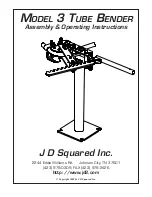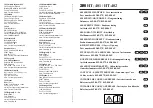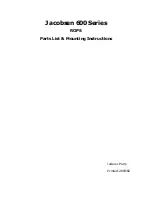
Page 51 of 112
TYMPANOMETRY AND IPSILATERAL/CONTRALATERAL REFLEXES (VERSION 2
AND VERSION 3)
This test sequence can be selected either temporarily or set as the default sequence. If both ipsilateral
and contralateral testing are performed only with certain patients, it is advisable to only change the
test parameters temporarily on an as needed basis. However, if the test protocol calls for ipsilateral
and contralateral testing with all patients, it is advisable to change the default settings. (See
226 Hz
Reflex
or
1000 Reflex
under
Program Mode
section).
Ipsilateral and Contralateral Acoustic Reflex testing
There are 4 frequencies of either Ipsilateral or Contralateral stimulus presentations available. They
can be all Ipsilateral, all Contralateral or a combination of both Ipsilateral and Contralateral. Ipsilateral
will always be presented first and the frequencies will always go from low to high. Any combination
of Ipsilateral and Contralateral frequencies can be programmed into the 4 stimulus conditions. For
example,
I
500
C
1000
C
500
C
2000
or
I
500
I
2000
I
1000
C
1000
Press the button to select the Tymp/reflex mode.
Press the
IPSI
button and select and deselect ipsilateral reflexes using the frequency buttons.
Press the
CONTRA
button and select contralateral reflexes required using the frequency buttons.
NOTE:
A total of 4 reflex frequencies are allowed. It is not possible to select a 5th reflex. To choose
different reflexes, you must first deselect those reflexes not desired.
Before initiating the test:
Position the insert phone securely in the ear canal of the contralateral reflex ear.
Position the probe into the ear canal of the test ear. When the green lamp changes from a blinking to
a steady state, the test sequence begins. First, a tympanogram is obtained and then, for 226 Hz probe
tone, the peak pressure from the compliance peak offsets by -20 daPa (or a + 20daPa for a positive
pressure peak). For 1000 Hz, the system is reset to 0 daPa. The reflex sequence begins automatically
by starting with the lowest ipsilateral test frequency and is followed by a second ipsilateral test
frequency if selected. After the ipsilateral reflex tests are completed, the instrument sequences
automatically to the contralateral reflex test stimuli. The lowest frequency is presented first and is
then followed by the next frequency. Monitor the ear canal where the probe is positioned. When the
green probe lamp is no longer illuminated, the test is complete and it is appropriate to remove the
probe and the insert phone from the ears. The reflex test results can now be observed on the display
















































